Amps, Monitors, PA, etc
If you think chosing your VR out of 1/2 dozen of stage organs was a brain teaser … what would you say about the right speakers – out of hundreds? The follwing guide is for beginners that start their career with a VR – and some experienced guys that look for new ways.
- Mono vs. Stereo: The ‘PA-world’ is split into two oposit positions: those who claim that stage sound MUST be MONO (because instruments are ‘single point sound sources’, the audience will hear only R or L if not in the ‘stereo sweet spot’ etc etc etc) and (B) the STEREO-fans which argue that even ‘unbalanced stereo’ is still better than any mono…
It’s your decision – but consider the folloing: VR sounds (APs, organ etc) lose a lot of their quality if used ‘mono’: VR has no ‘mono-samples’ (AP, EPs) – if you use the Mono/L line-out, the VR simply adds R and L stereo signals, which produces heavy phase distortions resulting in false, ugly sounds (particulary APs). If you want realistic Leslie sound the only possibility are R-L stereo-setups with 2 speakers or ‘3D’ concepts like Aspen Spacestation - Studio-Monitors: speakers designed for ‘mixing applications’ at ‘nearfield’ listening distance of 1-2 meters with rather analytical ‘cold’ sound character. Not suited as stage-amps, limit keyboard monitor. Some of the studio monitors (e.g. Adam T7V) have a more musical and natural sound character and work well as ‘home’ speakers
- Stage-Monitors: speakers designed to ‘hear your own keyboard’ on the stage. Must be robust with sufficient power to compete against the drum kit or the guitar amps. More powerful units can be used as keyboard-amp for smaller gigs (pubs, garden party etc)
- Classical keyboard amps (like Roland KC series): date back to the 70th – when ‘digital pianos’ sounded horrible – but had to be ‘loud’. Keyboard amps are usually heavy and the ‘old’ concept is a bit outdated for the sound quality of todays keyboards. Though there are a few ‘modern’ interpretations of keyboard-amps with good linear ‘natural’ sound
- Modern 2.1 mini-PA (subwoofer + tops): modern ‘mini-PA’ systems with minimal weight and near high-fidelity sound are a very good usage as ‘keyboard-amp’: designed with a full-range ‘all sounds’ PA characteristics they are perfect for the wide range of keyboard sounds and have enough omp to be heared against drums and guitar (ex.: HK Audio Nano 300/600-series, Thomann Satmix, CURV 500, etc)
- Full-PA column stack systems (Maui 11, Maui 28, HK Audio, Behringer Turbosound, RCF Evox series, etc): modern PA systems with excellent sound that can serve as ‘keyboard-amp’ or PA the entire band
- ‘Used’ amps: the good old 15″ nuclear bombs from last century… awful sound or/and huge and heavy. Speaker technology has made giant steps since those days…
Selected amp models
The list can only be a minuscule excerpt of hundreds of available amps. Its primary intention is to give you some ‘ideas’
| The ‘sound rating’ is taken with respect to a neutral and ‘natural’ reproduction of ALL keyboard sounds, particulary with respect to the most demanding sound which is acoustic piano (AP) Your personal ideal of ‘good sound’ can (and will) differ from the rating, e.g. if you play only organ or electric pianos (EPs) you might prefer a more ‘colorized’ sound like Roland Jazz Chorus |
explanation for the tables: Usage: ‘stage’ = ‘full stage kbd amp’ / ‘monitor’ = keyboard stage monitor / ‘home’ = practice speakers for home use
Price: ca-price in Euro/Europe. +/- equal to USD
Rating: +: good, o: acceptable -: un-acceptable
gen(eral) rating: ties an objective summ of usabiltiy, price/quality, mobilty, sound, issues, etc etc.
s(ou)nd rating: in terms of neutral and ‘natural’ reproduction of ALL keyboard sounds
-
Mono-Amps
Note: 2 units needed for stereo. Some system have ‘link’ connections for the 2nd (stereo) unit
Amp Usage Price Rating Remarks Roland KC ‘Mono’ series stage monitor home 400 … 1300 gen: o
snd: –Classical keyboard amp. Bullet prooved. The big models are ultra heavy. Nonlinear frequency curve is not suited for APs. ‘boxy’ sound (typical ‘KC’-sound). Behringer KXD12 KDX15 stage monitor home 250 300 gen: +
snd: oLow bugdet keyboard-amp but with quite linear sound quality (for one big full-range driver). A lot of features like 4x stereo-in, effect section, 7-band EQ. Stereo-‘link’ for connecting a 2nd unit. Yamaha DBR10 DBR12 stage monitor (home) 400 gen: +
snd: +Yamaha budget active speakers, good sound and very popular. Powerfull and can serve as stage monitors, keyboard-amps and mini-PA. In the decision 10″ vs 12″ the weight (10kg vs 15kg) might play a role RFC-Art QSC-K10 QSC-K12 stage monitor (home) 700 gen: +
snd: +Popular active (monitor) speakers from ARC and QSC in the rised price range. Ppowerfull and can serve as stage monitors, keyboard-amps and mini-PAs. The version with 12″ drivers are not always louder and even might have too much bass for keyboard – something to test with the band Behringer 205D monitor (home) 120 gen: o
snd: oA ‘monitor-classics’. Full-range mono stage monitor. Bullet proove and very light (3kg). 4 channels in, 3-band EQ, ‘link’ system for chaining multiple units. -
Twin-Stereo-Amps
Note: The amps have two ‘stereo-speakers’ placed in parallel in the chassis. ‘stereo’-panorama disappears with listening distance. Phase distortions of stereo sounds can appear.
Amp Usage Price Rating Remarks Roland KC110 KC220 busking 450 gen: –
snd: –Lightwight (7kg). Can run on batteries. Nonlinear frequency curve is not suited for APs, resulting in harsh, metallic sound
Loud and annoying chassis vibrations with APs, EPs and organs. Heavy distorsion if vol > 50%. Stereo effect disappears at distance > 1m. Builtin ‘Stereo-Wide’ is a chorus-effect and unsuable. Soundwise the little KC cannot be recommended for keyboard/organ (it works verry well for amping acoustic guitars though). Even for busking modern speakers are lighter, better sounding and less expensiveRoland KC880 KC990 stage monitor home 1300 gen: o
snd: –Bullet proove. Ultra heavy. Loud. Nonlinear frequency curve is not suited for APs. ‘boxy’ sound (‘KC’-sound). Roland SA300 SA1000 stage monitor home 2nd hand (400-600) gen: +
snd: +Keyboard-amp + mini-PA with clever split concept. Lightweight (2 parts, each 10kg). 3-way speakers (12″ sub + stereo 6.5″+tweeters) with very linear frequency range (much better than ‘KC’ series) working nicely for all keyboard sounds and voice. Can be used as monitor, keyboard-amp or mini-PA for small gigs (‘Link’-feature to combine 2 systems + feedback-killer to put it ‘behind’ the band without monitors). SA1000 has an ‘organ enhancer’ for keyboards but basically 300/1000 are identical. Available 2nd hand (in EU: ca 400-600€). Traynor K4 stage monitor home 2nd hand (400-600) gen: o
snd: oKeyboard-Amp. Powerful. Rather heavy (23kg). Builtin tube preamp. Repeated build quality issues. Available 2nd hand -
Twin-Stereo-‘3D’-Amps
Note: these amps have ‘twin drivers’ but use electronical or acoustomechanical tricks to create a wide stereo panorama (see also next section ‘mini-PA’)
Amp Usage Price Rating Remarks Space-station V.3 stage monitor home 900 gen: +
snd: +Aspen Pittman Design Spacestation V.3. Compact and lightwight (14kg) keyboard amp. Produces an electronic stereo ‘3D effect’. Eventually too weak as keyboard-amp in a loud band. Some complains about amp ground hizz Space-station XL stage monitor home 1400 gen: +
snd: +Big brother of V.3, louder but very heavy (30 kg) Viscount Hurricane 210 stage monitor home 1400 gen: o
snd: +From Viscount ‘Legend’ series for organs. Special arrangement of speakers for a 3D stereo and Leslie effects. Ultra heavy (44kg) Motion Sound stage monitor home 1000 … 2000 gen: +
snd: +Motion Soun KP series with ‘3D Expander’ space sound effect. Good, heavy and expensive. -
2.1 ‘mini-PA’
Note: these amps have excellent full-range characteristics and can serve as keyboard amp, monitor or even mini-PA. Tops can be set up like shown in the photo below to create a wide stereo-image (or placed on 2 stands as classical R-L speakers)
Amp Usage Price Rating Remarks Thomann Satmix 2.1 stage (monitor) 300 gen: +
snd: +Lightweight (20kg). Large tops with arrayed drivers omit typical 2.1 ‘mid frequency gap’. Good highs, big bass. Works nice for all VR sounds. VERY powerful and loud. Usage as keyboard-amp or mini-PA (excellent representation of voices). Integrated mixer (mic-ins with active feedback suppression!), EQ, Reverb, Bluetooth. Not suited for home use (no good nearfield sound). Killer price HK Audio Nano 300 series monitor home 550 … 900 gen: +
snd: oSuperlightweight (10kg), clever ‘transport system’. Acoustic gigs and stage monitor (not enough power as stage-amp). Also for home-cinema, BBQ-party etc. Cooling fan might prevent home use. Several variants with mixer, FX etc HK Audio Nano 600 series stage monitor (home) 900 gen: +
snd: +Lightweight (16kg), clever ‘transport system’. Big brother of Nano-300: more bass, better resolution of highs (tweeter), overall better sound. Stage monitor, stage-amp and mini-PA. Also for home-cinema, BBQ-party etc. Cooling fan might prevent home use. Several variants with mixer, FX etc Dave-8XS Dave-10 Syrincs-M3 stage monitor home 400 … 600 gen: +
snd: +Multipurpose (fan-less) mini-PAs can be used as PC-speakers, for home cinema, BBQ party, practice-amp for home, stage-monitor – or for small gigs as keyboard amp. Sound is very good (near ‘hifi’ quality) -
Exotics
Note: a ‘think different’ approach 🙂
Amp Usage Price Rating Remarks Roland CUBE 60 ‘Keyboard’ stage monitor home 100 2nd hand gen:+
snd: +The ‘Roland Cube 60 Keyboard’ is an ‘UK build’ amp from the 80th (1981-1995). It’s compact, weights 16kg and has an extremely good sound (out-sounding modern ‘Cubes’ or ‘KCs’ by miles) – it’s also an insider tip amoungst Jazz- and acoustc guitar players that appreciate its ‘overall-frequency equilibration and cristal-clear detail resolution while conserving a ‘warm’ tone. Technique is rock solid, used models are sold around 100 Euros/USD. 2 Cubes (200 bucks) built a very powerfull stereo amp system that soundwise competes with much higher priced modern active amps Hifi system home – gen:
snd: +For playing and practicing at home you can try a hifi system (e.g. those old analog amps/speakers that you kept in the cave and could never separate from…). Low spec speakers might work well whereas superior hifi gear might not. A good working speaker pair will outperform any studio monitor in the $500 class.
There are a lot of warnings about damaging the drivers due to the ‘high dynamics’ of keyboard sounds, but as long as you don’t push the speakers to their max, there is not more risk than blowing up studio monitorsHome cinema system home – gen: +
snd: +In 2.1 configuration (sub + 2 sats) home cinema system can do an amazing job especially with fat synth sounds. They usually lack mids for the perfect reproduction of acoustic pianos. Note: never use AVR receivers: apart from few exceptions they lack power for driving passive speakers and sound quality is miles behind any mid-class stereo-amp BT-speaker Boom-box home jam beach travel 100 – 200 gen: +
snd: +If you look for light ‘travel’ or ‘mini-jam’ amps (acoustic jam, beach party…) consider modern ‘stereo Bluetooth speakers’. The “30 Watt range” (e.g. Anker Motion+, JBL Extreme …) are light (ca 1kg) but have a suprisingly powerfull full-range sound. You can also get a pair of Boom-boxes.
The speakers are water and dust resistant (beach !!), build-in batteries last for 10 hours.
Attention: the device must have analog stereo audio/aux-in Bluetooth has too much latency for playing instruments and on some models, even analog audio has latency
Tip: BT speakers gain much on sound when placed on ‘resonant boxes’, e.g. floor or the VR chassis itself
Roland SA1000 / SA300The very beautiful, lightweight and good sounding (stereo) Roland SA-1000, specifically desinged as keyboard-organ-amp (its sister model ‘SA300’ is a bit more of a ‘PA’, but also works well as organ/key amp). Not produced any more but available 2nd hand (very often in good condition) |
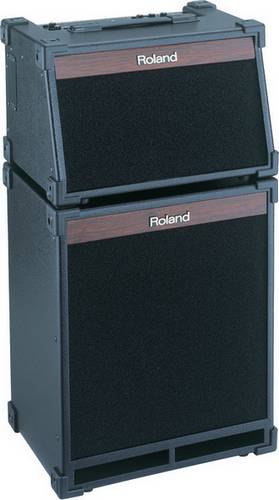 |
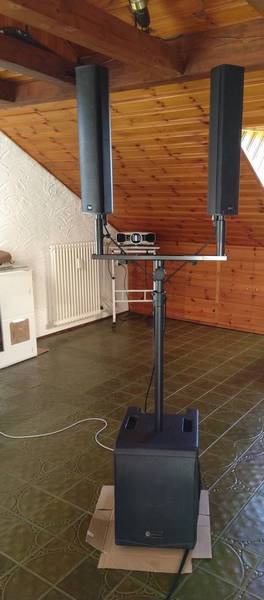 |
2.1-mini-PA ‘3D’ setupExample of a dedicated stereo ‘3D space’ keyboard-amp setup using a 2.1 mini-PA for small venues (pub gigs, small halls etc), especially when there’s not much room to place R+L speaker towers: 2.1 system with tops at a distance of ca. 50cm and turned to the outside for ca. 45o. The tops are running in stereo and use wall+roof reflections to ‘fill the room’ with 3D Leslie or stereo-tremolo sound. Works also well for acoustic piano (much better sound than pure mono) |
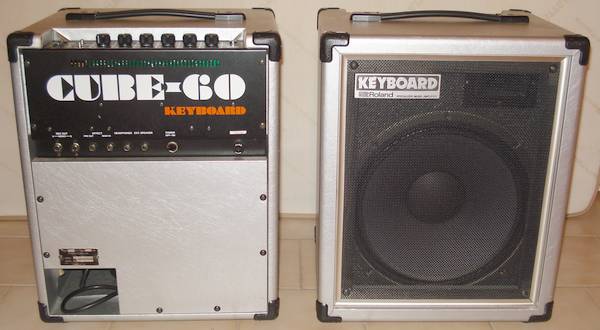 |
Roland CUBE 60 KEYBOARDRolands excellent keyboard-amp from the 80th/90th is an impressive contender to modern active amps. Usually sold 2nd hand for 100-150 bucks. 2 of them can build a powerfull stereo ‘mini PA’. If you love ‘vintage’, the Cubes are an interesting (and far less expensive) alternative to modern ‘plasic boxes’ (including modern ‘Cubes’ or ‘KCs’ !) |
Bluetooth speakersBT speakers with analog-in for travel, party … |
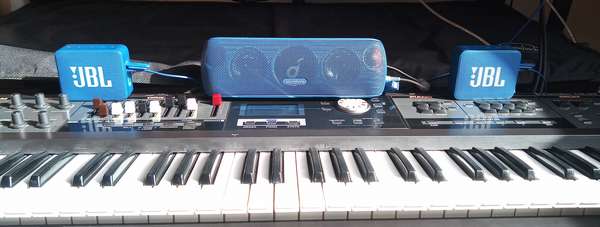 |
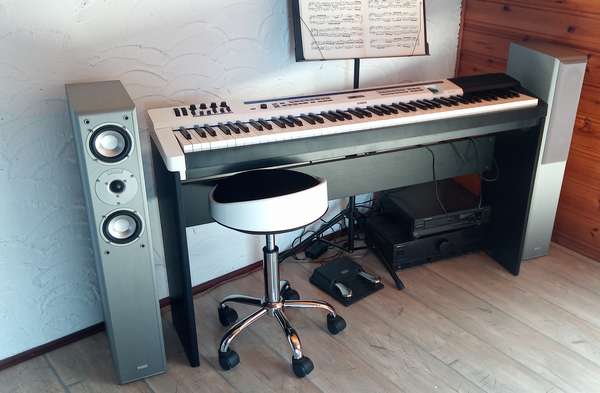 |
Hifi / home cinemaA pair of front speakers of a low budget 5.0 ‘home-cinema'(Magnat Motion 990) powered by a 1990th Kennwood hifi amp provide an amazingly powerfull, detailed and ‘warm’ sound canvas. Note that the Magnats are 3-way speakers with integrated ‘cinema’-subwoofer – so that’s robust. They are a bit muffled at highs – but here it compensates perfectly the slighty shrill ‘Grand’ of the Casio PX5S |